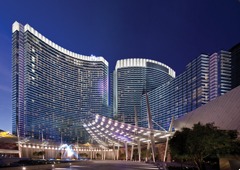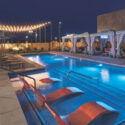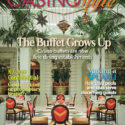
In the beginning was the Sahara. Las Vegas’ “jewel of the desert,” the Sahara Hotel and Casino was a Moroccan-themed oasis with gold-tipped minarets, neon camels, African warriors and towering palms. In its heyday in the 1950s and ’60s, stars including Elizabeth Taylor, Marilyn Monroe and Elvis could be spotted at the Garden of Allah pool, which resembled the reflecting pool at the Taj Mahal.
At the end, which came in May 2011, the former playground of the Rat Pack seemed almost out of place on a Las Vegas Strip it helped to define. When it closed in May, the Sahara featured dollar-blackjack and burrito-eating contests. In its NASCAR bar, a replica of Dale Earnhardt’s race car was on display—with a flat tire, dents in the hood and coins haphazardly tossed on the front seat.
Evolution not Revolution
The Sahara’s demise is the latest milestone in an evolving Las Vegas Strip. Though hotelier Sam Nazarian bought the place to restore it, the timing was brutal—2007, just as the economy was starting to crater. And while Nazarian “had a good design plan in motion,” says architect Brett Ewing of Thalden Boyd Emery of Las Vegas, “the property is in a very poor location. In order to draw the market to the Sahara, it was going to require substantial capital. The ROI isn’t there in today’s economy.”
As a result, the historic Sahara ended with padlocks on those famous doors along with the sign, “Thanks for the memories.”
The recession has forced a number of gaming companies to suspend expansions and sell off properties. That fast shuffle has put plenty of bargains on the table, but after the acquisition comes the renovation. How do you refresh a property that’s priced right, but a little worse for wear?
One example of a quick, cost-conscious redo is the Siena Hotel Spa Casino in Reno. The resort’s last big overhaul, in the late 1990s, cost $20 million. When the Siena went bankrupt in 2010, an investment group picked it up for just $3.9 million, and remade it as a boutique resort in just five months. Workers ditched the Old World Italian décor for an ultra-contemporary look meant to draw a sophisticated clientele.
The new Siena has a luxury spa, lots of marble, and a veritable gallery of imported art. The work is not yet complete, but the renovation so far has cost just $5 million—more than the actual sale price, but a quarter of the previous renovation.
Buffalo Bill’s in Primm, Nevada, hit the jackpot when a Las Vegas mega-project went south. As part of a recent $1.5 million upgrade, Bill’s picked up about $500,000 worth of sleek, modern furniture once destined for the Fontainebleau, the unfinished resort on the north end of the Strip. About half of Buffalo Bill’s 1,242 rooms have benefited from the sell-off—a bargain-basement renovation that cost an economical $800 per room.
Ewing cites his company’s project, the Cherokee Hard Rock Hotel and Casino in Tulsa, as an “expansion and re-branding that has been remarkable addressing an untapped market.” Others include Treasure Island, purchased from MGM Resorts by Phil Ruffin, who is “strategically renovating it to a specific middle market. This is a great example of the strength of a sole proprietor,” says Ewing.
The Mirage is another example of a property with intact architecture and infrastructure that has “implemented substantial interior remodels to keep the property top-notch.”
Scheduled Upgrades
As a rule, hotel-casino upgrades are budgeted on a five-to-seven-year schedule as part of capital expenditures; with the economy still uncertain, that once-fixed cycle has now become more elastic, with some properties pushing it up to a decade.
But failing to maintain and improve in a competitive environment may be the definition of “penny-wise and pound-foolish.” Especially when a property changes hands, a new look signals to customers that they have something to look forward to, or a reason to come back.
While all eyes are on the bottom line, if the chips are down and ROI is in decline, renovations must be made “inside and out to the greatest extent possible within the budget,” says architect Joel Bergman.
“Customers don’t care about maintenance and operating costs; they care about what’s appealing, what’s sexy, what gets their juices flowing,” says Bergman, of Bergman Walls and Associates in Las Vegas. “If all I give a damn about is operating costs, I don’t stand a chance of getting new customers and pulling back old ones. I’ve got to ask, ‘What’s going to grab people, get them excited, get them talking to their friends? What’s going to get the media jazzed up?’”
While upgrading colors and finishes and swapping out furniture, fixtures and equipment are the first steps in the playbook, it’s just as important to find the pizzazz. For a casino hotel outside Minneapolis, the answer was a single dramatic fixture.
Mystic River, a onetime ragtag tribal property, had seen half a dozen additions over time, but never achieved a unifying theme or link. With almost 650,000 square feet of disjointed casino, hotel, retail and convention space, the property posed an interesting challenge for Bergman Walls and the Cuningham Group, enlisted by the Shakopee Mdewakanton Sioux to collaborate on a remedy.
Their solution was simple but striking. Designers came up with a fiery “Golden River” ceiling feature that not only organized the gaming space but created a dynamic flow from the casino to adjoining areas of interest, like shops and restaurants. Patrons naturally found themselves following what could be described as an inverse Yellow Brick Road; the design won a 2010 FAB Award in the hospitality category.
“It became a vibrant, flowing space, a common river running through the ceiling,” says Bergman. “The customers loved it; it was just
a happening.”
Public Perception
Although it’s important to renovate with ease of maintenance, durability and safety in mind, subtle changes or simple upkeep won’t create a sufficient change in perception among the public, says Bergman.
“You have to spend seriously on the front of the house, change the things visitors can see from the moment they arrive,” he says.
Ewing notes that physical comfort—that sometimes-overlooked essential—is as vital to the successful casino hotel as “color, space, lighting and all the other things we love to talk about.”
“Maybe there are functional issues you have to handle; do something with walls and ceiling, resolve spatial issues if it’s not a comfortable space. Sometimes if the climate is off—if it’s cold and customers are just not comfortable—that can kill an opportunity.” For older patrons, lighting must be enhanced and signage must be clear and bold.
As importantly, says Ewing, marketing must be backed up with unstinting service.
“You have one shot at attracting that customer on the fence, the one who’s thinking, ‘Should I try this place or not?’ Service has to line up with any design change and marketing. There is so much product out there. The customer pocketbook is limited, and people are making more intelligent decisions.”
While the Siena courts the moneyed older crowd, Mystic Lake woos the locals, and family-friendly Buffalo Bill’s goes for the super-affordable renovation, the trend in Las Vegas proper is toward young, hip and ever-new, says John Platon, senior vice president of KHS&S Contractors.
“Gen X has taken over. It used to be old-school guys like me going to the bars and clubs,” says Platon. “Now it’s these 23-to-30-year-old beautiful people who stand in line for three hours to get into the latest cool club and spend the rent on bottle service.”
With capital expenditures tight, Platon says casinos are relying on entertainment to get people on property. Once there to see the superstar concert, showroom spectacular or celebrity deejay, hopefully they spend; if the formula works and is repeated often enough, a property stands a chance of building customer loyalty.
“It costs a lot of money to put on a show,” says Platon, “but after 5,000 people are drunk and done, they go and gamble. The challenge is getting them there.”
Bar Stars
The Tropicana in Las Vegas is getting them there with a $180 million renovation that brought a South Beach vibe to its Strip property. Like the Sahara, the Trop opened in the 1950s, but managed to rebrand itself for a contemporary clientele. The casino has implemented the usual upgrades—new furniture, new carpets, and new slots and tables, along with renovated hotel rooms and three new restaurants.
But the buzz centers on Nikki Beach, a 15,000-square-foot day-to-night club that takes its cues from other successful venues in the franchise, in Miami, Cabo San Lucas, Marrakesh and Saint-Tropez.
Ewing applauds the all-purpose club that “stretches from 10 a.m. to 3 a.m., indoor and outdoor.
“We’ve had several spaces at Rio, a theater that had a supper club and turned to an entertainment space with a video wall, then turned into a popular club. Encore’s Surrender nightclub and Beach Club are great spaces, and very successful. You go out in the morning for the pool and sun, and at night it turns into a nightclub.”
But the casinos should not forget their core customers in the pursuit of younger patrons, Ewing warns.
“I was at Cosmo with my daughter who’s in town. She’s 21, and we went to the Chandelier Bar. The place was packed; the food and beverage, restaurants and entertainment are all doing well. But the gaming revenue isn’t there. I looked into the slot and table areas, and they weren’t busy on a Friday night in primetime. If you go to Bellagio, which has an established gaming reputation, you don’t see the same thing.”
Those demographic tiers—free-spending young partiers versus established slot players—are “the root of a big discussion,” says Ewing. “The beautiful people are spending most of their money on $15 drinks. They’re not gaming as much.
“When it comes to traditional customers, those from 55 to 70, they need to go into places where the lighting is good. Sometimes contemporary lighting is dim, and the signage is not clear, it has an elaborate font or something that is hard to read, and that makes people uncomfortable. All these factors have an impact, and that older customer should not be counted out. They have more disposable income and they have more time,” as well as a tradition and history of gambling.
Amazing Amenities
Today’s casino is more than just a gaming floor, hotel rooms and restaurants. It’s a collection of attractions that make the sum of the parts greater than the whole.
Richard Rizzo, vice chairman of Perini Building Co., agrees that success in the casino industry today is more “venue and entertainment-driven.”
“It’s not just the facility itself, but a lot more about the nightclubs and uniquely themed restaurants and shows,” says Rizzo. “It’s now more about who we are and what we look like than what we’re offering.
“Take as an example CityCenter,” Rizzo says. “It has a bit of everything, but no common theme through the place other than a holiday, urban setting. It’s just a backdrop to everything else that’s happening inside the facility, the accumulated venues and attractions that get people there. There are 35 restaurants, outside-the-box retail, the highest-end shopping in the country—those are the unique features that draw people and get them to spend money. People want to be entertained.”
Paul Steelman, CEO of Steelman Partners of Las Vegas, argues that all change is not for the better, and Las Vegas should not position itself as “an urban shopping mall.”
In the past, says Steelman, “The Strip was a street where the grand signature resorts were located”—resorts with “suburban oasis-types of landscaping and design” and “beautiful front yards.”
Now, says Steelman, many of those grand resorts have added “out of theme” additions and signage that “virtually destroy the original aesthetic.”
“Many of the projects have crammed themselves as close to the Strip as possible, eliminating the suburban experience and creating the dreaded urban aesthetic,” Steelman laments.
Ewing admires CityCenter’s architecture, but calls it “psychologically cold, without a warm residential feeling.”
Bergman is also critical of the so-called “vertical resort,” calling it “an office building—not entertaining, not customer-friendly.” He adds that it should never be the goal of any resort to overwhelm its customers or make them feel they’re in the wrong place.
“Our audiences are not that sophisticated,” says Bergman. “They come to let their hair down and hang out. They want to give us their money, but they want to do it their way. The Bellagio, the Mirage, Paris let them do it their way.
“People don’t want to be educated,” Bergman adds. “They don’t want to be sophisticated. They want to relax with their shirt out, wearing their tennis shoes.”








